BendixKing IN-182A User Manual
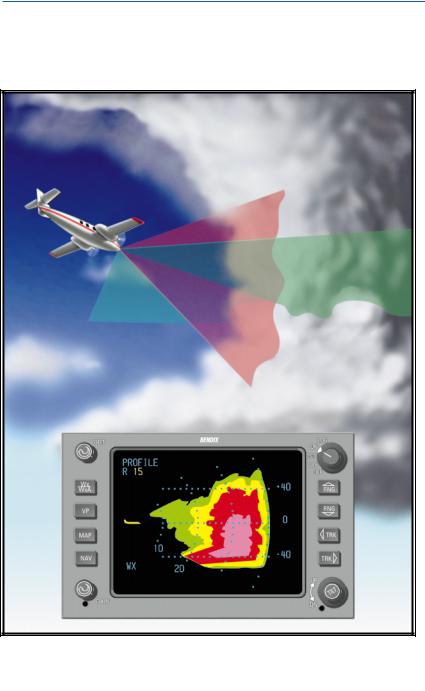
Pilot’s Guide RDR 2000
Digital Weather Radar System
B
006-08755-0001 Revision 3
S
WARNING
Information subject to the export control laws. This document, which includes any attachments and exhibits hereto, contains information subject to International Traffic in Arms Regulation (ITAR) or Export Administration Regulation (EAR) of 1979, which may not be exported, released or disclosed to foreign nationals inside or outside the U.S. without first obtaining an export license. Violators of ITAR or EAR may be subject to a penalty of 10 years imprisonment and a fine of $1,000,000 under 22 U.S.C. 2778 or Section 2410 of the Export Administration Act of 1979. Include this notice with any reproduced portion of this document.
COPYRIGHT NOTICE
©1996-1998 AlliedSignal, Inc.
Reproduction of this publication or any portion thereof by any means without the express written permission of AlliedSignal Electronic and Avionics Systems is prohibited. For further information contact the Manager, Technical Publications; AlliedSignal Electronic and Avionics Systems; One Technology Center; 23500 West 105th Street; Olathe, Kansas 66061. Telephone: (913) 782-0400.

Table of Contents |
|
RDR 2000 OPERATIONAL CONTROLS . . . . . . . . . . . . . . . . . . . . . . . . |
. . . .1 |
TEST PATTERN . . . . . . . . . . . . . . . . . . . . . . . . . . . . . . . . . . . . . . . . |
. . . .4 |
FAULT ANNUNCIATIONS . . . . . . . . . . . . . . . . . . . . . . . . . . . . . . . . . |
. . . .4 |
PREFLIGHT . . . . . . . . . . . . . . . . . . . . . . . . . . . . . . . . . . . . . . . . . . . . . . . |
. . . .5 |
PREFLIGHT WARNINGS . . . . . . . . . . . . . . . . . . . . . . . . . . . . . . . . . |
. . . .5 |
THEORY OF OPERATION . . . . . . . . . . . . . . . . . . . . . . . . . . . . . . . . . . . |
. . . .7 |
GENERAL . . . . . . . . . . . . . . . . . . . . . . . . . . . . . . . . . . . . . . . . . . . . . |
. . . .7 |
RADAR PRINCIPLES . . . . . . . . . . . . . . . . . . . . . . . . . . . . . . . . . . . . |
. . . .7 |
WEATHER RADAR PRINCIPLES . . . . . . . . . . . . . . . . . . . . . . . . . . |
. . . .8 |
RADAR BEAM ILLUMINATION . . . . . . . . . . . . . . . . . . . . . . . . . . . . |
. . . .8 |
RADAR TILT ANGLE CALCULATOR USER INSTRUCTIONS |
. . .10 |
RADAR REFLECTIVITY . . . . . . . . . . . . . . . . . . . . . . . . . . . . . . . . . . |
. . .13 |
WEATHER DISPLAY CALIBRATION . . . . . . . . . . . . . . . . . . . . . . . . |
. . .14 |
WEATHER ATTENUATION COMPENSATION . . . . . . . . . . . . . . . . |
. . .15 |
TARGET ALERT . . . . . . . . . . . . . . . . . . . . . . . . . . . . . . . . . . . . |
. . .17 |
ALTITUDE RING (RANGE RING) . . . . . . . . . . . . . . . . . . . . . . . |
. . .18 |
RADOMES . . . . . . . . . . . . . . . . . . . . . . . . . . . . . . . . . . . . . . . . . |
. . .18 |
WEATHER MAPPING AND INTERPRETATION . . . . . . . . . . . . . . . . . . |
. . .20 |
OBSERVING WEATHER . . . . . . . . . . . . . . . . . . . . . . . . . . . . . . . . . |
. . .20 |
THUNDERSTORMS & TURBULENCE . . . . . . . . . . . . . . . . . . . . . . |
. . .21 |
TORNADOES . . . . . . . . . . . . . . . . . . . . . . . . . . . . . . . . . . . . . . . . . . |
. . .21 |
HAIL . . . . . . . . . . . . . . . . . . . . . . . . . . . . . . . . . . . . . . . . . . . . . . . |
. . .22 |
ICING . . . . . . . . . . . . . . . . . . . . . . . . . . . . . . . . . . . . . . . . . . . . . . . |
. . .23 |
SNOW . . . . . . . . . . . . . . . . . . . . . . . . . . . . . . . . . . . . . . . . . . . . . . . |
. . .23 |
LIGHTNING AND STATIC DISCHARGES . . . . . . . . . . . . . . . . . . . . |
. . .24 |
GROUND MAPPING AND INTERPRETATION . . . . . . . . . . . . . . . . . . . |
. . .25 |
LOOKING ANGLE . . . . . . . . . . . . . . . . . . . . . . . . . . . . . . . . . . . . . . . |
. . .26 |
OPERATION IN-FLIGHT . . . . . . . . . . . . . . . . . . . . . . . . . . . . . . . . . . . . . |
. . .27 |
GENERAL . . . . . . . . . . . . . . . . . . . . . . . . . . . . . . . . . . . . . . . . . . . . . |
. . .27 |
TILT MANAGEMENT . . . . . . . . . . . . . . . . . . . . . . . . . . . . . . . . . . . . |
. . .27 |
EARLY DETECTION OF ENROUTE WEATHER . . . . . . . . . . . |
. . .29 |
SEPARATION OF WEATHER AND GROUND TARGETS . . . |
. . .29 |
SHADOWED AREAS . . . . . . . . . . . . . . . . . . . . . . . . . . . . . . . . . |
. . .32 |
Effective Date: 5/98
i |
RDR 2000 Pilot's Guide: Rev 3 |

Table of Contents
TARGET RESOLUTION . . . . . . . . . . . . . . . . . . . . . . . . . . . . |
. . . . .32 |
RANGE RESOLUTION . . . . . . . . . . . . . . . . . . . . . . . . . . . . . |
. . . . .32 |
AZIMUTH RESOLUTION . . . . . . . . . . . . . . . . . . . . . . . . . . . . |
. . . . .33 |
PATH PLANNING . . . . . . . . . . . . . . . . . . . . . . . . . . . . . . . . . . . . . |
. . . . .33 |
PATH PLANNING CONSIDERATIONS . . . . . . . . . . . . . . . . |
. . . . .34 |
ANTENNA STABILIZATION . . . . . . . . . . . . . . . . . . . . . . . . . . . . . . . . |
. . . . .36 |
CRITERIA . . . . . . . . . . . . . . . . . . . . . . . . . . . . . . . . . . . . . . . . . . . |
. . . . .36 |
PITCH ERRORS . . . . . . . . . . . . . . . . . . . . . . . . . . . . . . . . . . . . . . |
. . . . .36 |
TURN ERRORS . . . . . . . . . . . . . . . . . . . . . . . . . . . . . . . . . . . . . . |
. . . . .36 |
EFFECT ON RADAR STABILIZATION . . . . . . . . . . . . . . . . . . . . |
. . . . .37 |
DURING TAKEOFF . . . . . . . . . . . . . . . . . . . . . . . . . . . . . . . . |
. . . . .38 |
SHALLOW-BANKED TURNS . . . . . . . . . . . . . . . . . . . . . . . . |
. . . . .38 |
STABILIZATION LIMITS . . . . . . . . . . . . . . . . . . . . . . . . . . . . |
. . . . .38 |
STABILIZATION FLIGHT TEST CHECKLIST . . . . . . . . . . . . . . . |
. . . . .40 |
VERTICAL PROFILE (VP) THEORY OF OPERATION . . . . . . . . . . . |
. . . . .42 |
VP OPERATION IN-FLIGHT . . . . . . . . . . . . . . . . . . . . . . . . . . . . . . . . |
. . . . .42 |
VERTICAL PROFILE . . . . . . . . . . . . . . . . . . . . . . . . . . . . . . . . . . . |
. . . . .42 |
OPERATION . . . . . . . . . . . . . . . . . . . . . . . . . . . . . . . . . . . . . . . . . |
. . . . .43 |
WEATHER RADAR INTERFERENCE . . . . . . . . . . . . . . . . . . . . . . . . . |
. . . . .52 |
OPTIONS . . . . . . . . . . . . . . . . . . . . . . . . . . . . . . . . . . . . . . . . . . . . . |
. . . . .55 |
CHECKLIST . . . . . . . . . . . . . . . . . . . . . . . . . . . . . . . . . . . . . . . . . . |
. . . . .55 |
MOVING-MAP NAVIGATION . . . . . . . . . . . . . . . . . . . . . . . . . . . . |
. . . . .56 |
SPECIFICATIONS . . . . . . . . . . . . . . . . . . . . . . . . . . . . . . . . . . . . . . . . |
. . . . .57 |
RDR 2000 SENSOR (ANTENNA, RECEIVER, TRANSMITTER) |
. . . . .57 |
INDICATOR IN-182A . . . . . . . . . . . . . . . . . . . . . . . . . . . . . . . . . . . |
. . . . .58 |
APPENDIX: . . . . . . . . . . . . . . . . . . . . . . . . . . . . . . . . . . . . . . . . . . . . . |
. . . . .59 |
LICENSE REQUIREMENTS . . . . . . . . . . . . . . . . . . . . . . . . . . . . . |
. . . . .59 |
SAFETY INFORMATION . . . . . . . . . . . . . . . . . . . . . . . . . . . . . . . . |
. . . . .62 |
Effective Date: 5/98
ii |
RDR 2000 Pilot's Guide: Rev 3 |

Operational Controls
RDR 2000 OPERATIONAL CONTROLS
BRT - Controls brightness of the indicator display (CW rotation for max brightness).
Wx/WxA - Alternately selects between the Wx (weather) and WxA (weather-alert) modes of operation. “Wx” or “WxA” will appear in the lower left of the display. Wx or WxA colors are: Black for no returns, Green for weak returns, Yellow for moderate returns, Red for heavy returns and Magenta for intense returns. When the WxA mode is selected, magenta areas of storms flash between magenta and black at a 1 HZ rate.
- Selects and deselects the Vertical Profile mode of operation. When VP is selected on the indicator the radar will provide a vertical scan of ±30 degrees at the location of the horizontal track line. Selecting the VP mode of operation will not change the selected mode of operation: TST, Wx, WxA or GND MAP. Once in VP, these modes may be changed as desired. VP will engage from the NAV MAP mode, but NAV data will not
displayed during VP operation.
NAV MAP - Places indicator in navigation mode so that preprogrammed waypoints may be displayed. If other modes are also selected, the NAV display will be superimposed on them. This button is effective only if optional radar graphics unit and Flight Management System is installed. If activated without these units, NO NAV will appear at lower left of screen. The radar will display weather when NAV MAP is selected if the radar
selector is in the ON position.
GND MAP - Places the radar system in ground mapping mode. Gain control capability is configurable at installation to be enabled or disabled in ground map mode. Ground map colors are: green for weak returns, yellow for moderate returns and magenta for intense returns. “MAP” will appear on the lower left of the display.
Effective Date: 5/98 |
1 |
RDR 2000 Pilot's Guide: Rev 3 |
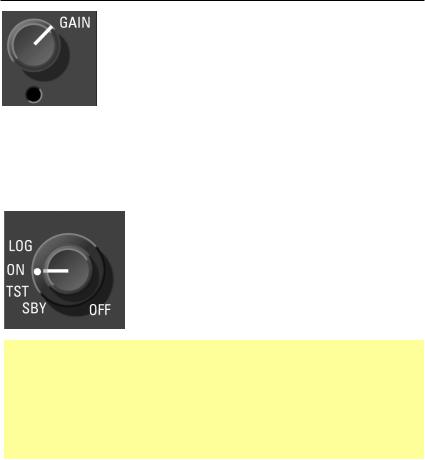
Operational Controls
GAIN - The gain knob adjusts the radar gain from 0 to -20 dB (CCW rotation reduces gain). The gain knob will only function when in the MAP mode.
LOG - Used when Bendix/King radar graphics units are installed. A listing of the latitudes and longitudes of selected waypoints are displayed. When a compatible navigation source is installed, the selected VOR frequencies along with bearings and distances are also displayed. The radar transmits in the LOG mode, unless a Bendix/King radar graphics unit (IU-2023, GC-360A or GC-381A) is installed.
ON - Selects the normal condition of operation for weather detection and/or other modes of operation. The system will transmit after a 60 second warm-up time is completed. The radar system initializes to the Wx mode, 80 nm.
Note: The 60 second warm up period can be monitored upon power up of the system. When the knob is switched directly from OFF to ON mode (or LOG mode with no Bendix/King radar graphics unit installed), the display will blank. As the radar sweeps the blue/white will grow outward. Just before the warm up period is complete, the screen will turn black for a few seconds, then the radar will begin transmitting and the screen will display radar returns. No radar transmissions occur until the warm up period is complete.
TST - The multicolored arc display test pattern is displayed in this mode of operation. The test pattern (typical 4-color test pattern on page 4) is initialized and sized to fit the 80 nm range and can also be scaled with the range select buttons. No radar transmissions occur while TST is selected. TEST will appear in the lower left of the display. STAB OFF is always displayed in top left.
SBY - Fully energizes the system circuitry but no radar transmissions occur in the SBY mode of operation. The antenna is parked at 0 degrees azimuth and 30 degrees tilt down with the antenna drive motors locked. In the standby mode of operation, NAV MAP, checklist and TCAS traffic can be activated with a Bendix/King radar graphics unit (IU-2023B, GC-360A, GC-362A or GC-381A) installed. SBY will appear in the lower left of the display.
Effective Date: 5/98 |
2 |
RDR 2000 Pilot's Guide: Rev 3 |
|
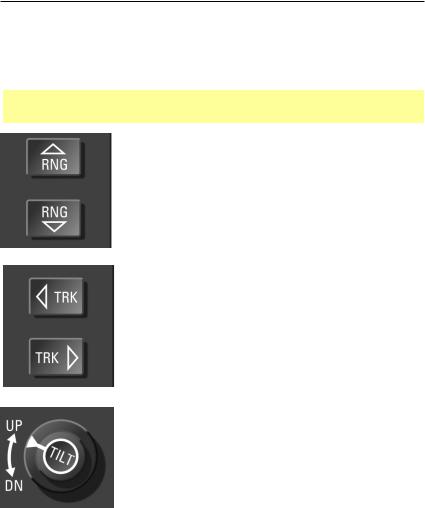
Operational Controls
OFF - Removes primary power from the radar indicator, but the radar still has power applied. The radar will remain active with no radar transmissions occurring, for up to a maximum time of 30 seconds. This time delay allows time to park the antenna at 0 degrees azimuth and 30 degrees tilt down.
Note: The only way to remove primary power from the radar is to pull the radar circuit breaker.
RNG - Clears the display and advances the indicator to the next range. The upper button increases range, the lower button decreases it. The RDR 2000 display ranges are: 10, 20, 40, 80, 160, 240 nm. The selected range is displayed in the upper right corner of the display with the range ring distance displayed along the right edge.
TRK - Provides a yellow track centerline for vertical profile. With the radar on and a track button pushed, the track line position moves left or right in 1 degree increments at a rate of about 15 degrees per second. When Vertical Profile mode is selected, the antenna scans the slice at the track line azimuth position. While in Vertical Profile mode, the TRK buttons move the slice left and right. The azimuth position of the antenna is displayed on the upper left corner of the indicator.
TILT - Permits manual adjustment of antenna tilt 15° up or down for best indicator presentation. The tilt angle is displayed in the upper right corner of the display.
Effective Date: 5/98 |
3 |
RDR 2000 Pilot's Guide: Rev 3 |
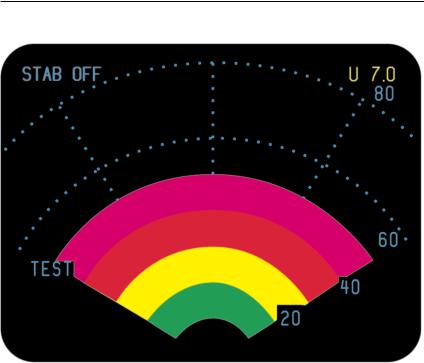
Operational Controls
TEST PATTERN
FAULT ANNUNCIATIONS
Fault annunciations are a method of alerting the pilot that the radar system is not performing to established standards. Built-in test equipment (BITE) automatically and constantly tests the radar system. If a fault occurs, the fault annunciation will be presented on the Display unit. There are two general categories of faults: hard failures and soft failure/annunciations. By careful observation of the Display, you can quickly evaluate the condition of the ART 2000.
Hard failures are those which occur when a major function of the system is lost. Hard failures are typically a total loss of transmitter power, receiver gain or no antenna scan. Turn off system. Should the system be left on, further damage to other system components could occur.
Hard Failures: |
|
Annunciation |
Failure |
TX FLT |
Transmitter failure |
429 FLT |
Loss of 429 bus data |
ANT FLT |
Loss of antenna position |
IN FLT 6 |
Loss of communication between |
|
display and ART |
Effective Date: 5/98 |
4 |
RDR 2000 Pilot's Guide: Rev 3 |

Preflight
Note: A TX FLT is indicated if the Strut switch is configured to be active and the aircraft is on the ground.
Soft failures are those which can cause limited system operation, Radar data will still be displayed but the flight crew should be aware that the display does not necessarily represent the true weather. Soft failures are typically configuration problem, stabilization problems, or some similar problem.
Soft Failures: |
|
Annunciation |
Cause |
TX FLT alternating with ANT FLT |
Configuration module not |
|
being read |
STAB LMT |
Stab. Is exceeding ±30˚ |
STAB OFF |
Alert that the scan is not being |
|
stabilized |
PREFLIGHT
PREFLIGHT WARNINGS
Do not turn the radar on within 5 feet of containers of flammable or explosive material. The radar should never be operated during fueling.
Do not attempt to operate the radar until you are completely familiar with all safety information, including that on pages 58 through 61.
The system always transmits in the ON mode, unless the aircraft is on the ground and the radar is interfaced to the strut switch. The radar transmits in LOG mode if the radar is not interfaced to a Bendix/King radar graphics unit. The system never transmits in the OFF, SBY or TST modes.
Accomplish the following procedures completely and exactly.
1)Place the radar controls in the following positions:
•Function switch to TST
•Tilt to UP 7 (as shown on the indicator display, upper right corner).
The test pattern will appear. See that the test pattern conforms to the illustration (The test pattern is sized to fit the 80 nm range and can be scaled with the range buttons), and observe the “update” action as a small ripple moves across the display along the outer edge.
Effective Date: 5/98 |
5 |
RDR 2000 Pilot's Guide: Rev 3 |

Preflight
2)With the function switch in TST or SBY, taxi to a clear area where there are no people, aircraft, vehicles, or metallic buildings within approximately 100 yards.
3)Rotate the function switch to ON. The indicator will automatically display in the Wx mode and 80 nm range. Any targets (weather or ground) will be displayed in green, yellow, red, or magenta. (Note: A 60 second warm up time period is required before the system will transmit).
4)Press the range-down button to display 40 nm as the maximum range.
5)Press the WxA button and observe that magenta areas (if any) flash.
6)Vary the tilt control manually between 0 and up 15 degrees and observe that close-in “ground clutter” appears at lower settings and that any local rain appears at higher settings.
7)Repeat the manual tilt adjustment, this time between the 0 and down 15 degrees positions.
8)Return the function switch to TST or SBY before taxiing!
9)When you are ready for weather detection (after takeoff or just before), place the function switch to ON and operate the system as described in the Operation In-Flight section.
Effective Date: 5/98 |
6 |
RDR 2000 Pilot's Guide: Rev 3 |
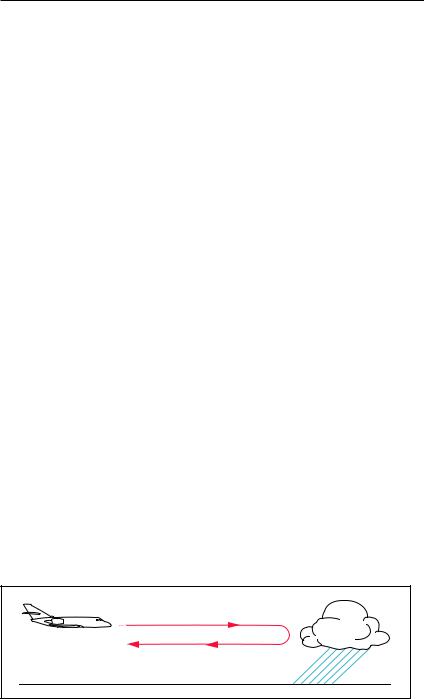
Theory of Operation
THEORY OF OPERATION
GENERAL
The primary use of this radar is to aid the pilot in avoiding thunderstorms and associated turbulence. Since each operator normally develops specific operational procedures for use of weather avoidance radar, the following information is presented for use at the operator’s discretion.
Operational techniques for the RDR 2000 are similar to earlier generation weather avoidance radars. The proficient operator manages antenna tilt control to achieve best knowledge of storm height, size, and relative direction of movement.
RADAR PRINCIPLES
Radar is fundamentally a distance measuring system using the principle of radio echoing. The term RADAR is an acronym for RAdio Detecting and Ranging. It is a method for locating targets by using radio waves. The transmitter generates microwave energy in the form of pulses. These pulses are then transferred to the antenna where they are focused into a beam by the antenna. The radar beam is much like the beam of flashlight. The energy is focused and radiated by the antenna in such a way that it is most intense in the center of the beam with decreasing intensity near the edge. The same antenna is used for both transmitting and receiving. When a pulse intercepts a target, the energy is reflected as an echo, or return signal, back to the antenna. From the antenna, the returned signal is transferred to the receiver and processing circuits located in the receiver transmitter unit. The echoes, or returned signals, are displayed on an indicator.
Radio waves travel at the speed of 300 million meters per second and thus yield nearly instantaneous information when echoing back. Radar ranging is a two-way process that requires 12.36 micro-seconds for the radio wave to travel out and back for each nautical mile of target range. As shown in the distance illustration below, it takes 123.6 micro-seconds for a transmitted pulse of radar energy to travel out and back from an area of precipitation 10 nautical miles away.
10 NM
20 NM ROUND TRIP IN 123.6 MICROSECONDS
Effective Date: 5/98 |
7 |
RDR 2000 Pilot's Guide: Rev 3 |

Theory of Operation
WEATHER RADAR PRINCIPLES
Airborne weather avoidance radar, as its name implies, is for avoiding severe weather, not for penetrating it. Whether to fly into an area of radar echoes depends on echo-intensity, spacing between the echoes, aircraft capabilities and pilot experience. Remember that weather radar detects only precipitation drops; it does not detect minute cloud droplets, nor does it detect turbulence. Therefore, the radar provides no assurance of avoiding instrument weather in clouds and fog. The indicator may be clear between intense echoes; this clear area does not necessarily mean it is safe to fly between the storms and maintain visual sighting of them.
The geometry of the weather radar radiated beam precludes its use for reliable proximity warning or anti-collision protection. The beam is characterized as a cone shaped pencil beam. It is much like that of a flashlight or spotlight beam. It would be an event of chance, not of certainty, that such a beam would come upon another aircraft in flight.
Note: Weather avoidance radar is not practical as a pilot operable terrain or collision avoidance system. Weather analysis and avoidance are the primary functions of the radar system.
RADAR BEAM ILLUMINATION
Probably the most important aspect of a weather radar is the antenna beam illumination characteristic. To make a proper interpretation of what you are seeing on the display, you must have an understanding of what the radar beam “is seeing”. The following figure is a side view of the radar beam characteristic with a storm depicted at a distance that causes the size of the storm to just fill the 3 dB beamwidth. This would be the typical situation for a storm at approximately 40 nautical miles with a 12 inch diameter antenna. It’s important to understand and visualize this situation, to enhance your understanding of the rest of this manual. First some observations are in order:
Effective Date: 5/98 |
8 |
RDR 2000 Pilot's Guide: Rev 3 |

Theory of Operation
Note that the antenna gain versus angle characteristic is a continuous function at all angles. This means that there is a gain value associated with all forward angles relative to the selected tilt angle. In this figure the tilt angle is shown as zero degrees. This means the beam center is along the same angle as the aircraft flight angle. Next, the points on either side of the beam where the antenna gain is down 3 dB relative to the maximum gain defines the 3 dB beamwidth. The remainder of the manual uses the cone shaped 3 dB beamwidth extensively to illustrate how the beam spreads with distance, much like a flashlight beam. Also important is the understanding that this angle is wider for smaller antennas (10”) and narrower for larger antennas. It’s also important to realize that the antenna gain does not go to zero outside the 3 dB beamwidth, it just continues to reduce with increasing angles. This is what it meant by a continuous gain function. This understanding is important when we discuss ground clutter reflections later.
Also note that there are small lobes of the gain characteristic at fairly large angles. These are called sidelobes. Generally these are not important since the gain value for these lobes is down 25 or more dB from the peak. However a bad radome can increase these sidelobes to a point that they cause a constant radar reflection from the ground. This is commonly referred to as an “altitude ring” because the display will show a concentric ring at a distance equal to the slant range of the sidelobe to the ground.
The cone formed by the 3 dB beamwidth is where most of the radar energy is concentrated, so it is important to realize that at any given time whatever is within this cone (and sometimes other strong targets like clutter outside the cone) is what is being painted on the display. The pilot should be aware of how wide this cone is as a function of range. The primary target of interest is obviously weather cells of significance. The typical cell is considered to be 3 nm in diameter. It is mandatory that the beam be pointed at the wet part of the weather cell to record the proper rainfall intensity (color level). To aid the pilot at accomplishing this task, the “Radar Tilt Angle Calculator” tool is provided (P/N 006-18124- 0000). This tool is a transparent 3 dB beamwidth overlay for each antenna size and range scales of 40, 80, and 160 nm in length, each of which has multiple weather cells shown to scale at different distances. A user can position the overlay on a given target and read the tilt angle that will position the beam at the “above freezing” part of the cell.
Effective Date: 5/98 |
9 |
RDR 2000 Pilot's Guide: Rev 3 |

Theory of Operation
RADAR TILT ANGLE CALCULATOR USER INSTRUCTIONS
This instructional tool includes overlays for 10”, 12” and 18” antennas. Use the overlay for the antenna size installed in the aircraft. If desired, the unwanted overlays may be detached by cutting the plastic of the unwanted overlay from the bottom edge to the fastener. Then, pull the plastic apart until it releases from the fastener.
Use the following procedure while viewing the following diagram to determine the proper radar antenna tilt angle in a given situation:
1)Choose one of the three range diagrams that matches the range selected on the radar. In this case we have chosen the 80 nm scale diagram.
2)Slide the overlay so that the left indice aligns with the aircraft altitude. This is best done keeping the overlay parallel to the diagram and grasping the extension tab and the overlay at the time.
3)Now, tilt the overlay (without sliding it up or down) so that the center line of the radar beam intersects the red (below freezing altitude) part of the range diagram at the range of the echo in question displayed on the radar screen. The above freezing part of the thunderstorm cell gives the best reflectivity for radar energy.
4)The correct tilt angle is shown where the degree mark aligns with the Tilt Angle Reference Line.
Note: To improve distinction between the weather echo and the clutter, increase the tilt angle. Remember, the correct weather intensity is shown at the tilt angle determined with the calculator.
The higher the altitude, the more down tilt is required. Therefore, clutter distinction is more of a problem. In this case, the intensity of the weather displayed should be noted from the tilt angle shown on the calculator. Now raise the tilt angle to push the ground clutter out in range to separate it from the weather display. The echo intensity will appear to weaken because the radar is looking at the freezing part of the cell. Remember to also use Vertical Profile on suspected cells.
Effective Date: 5/98 |
10 |
RDR 2000 Pilot's Guide: Rev 3 |
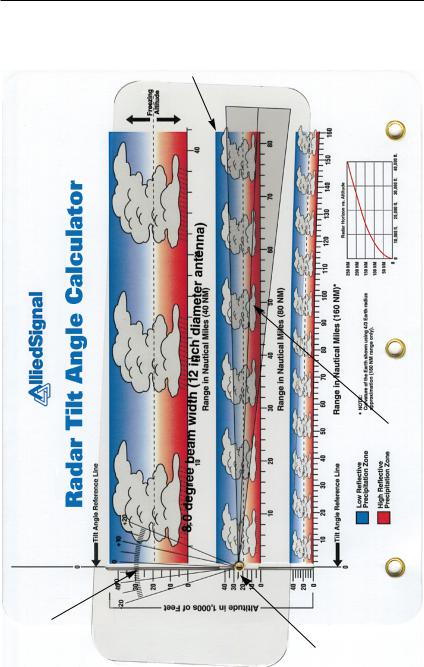
Theory of Operation
1
3
4
2
Effective Date: 5/98 |
11 |
RDR 2000 Pilot's Guide: Rev 3 |
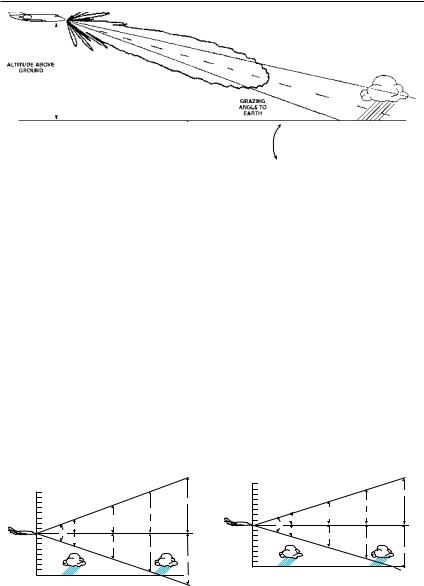
Theory of Operation
This tool should be understood and kept handy when trying to interpret the weather display.This tool illustrates that at greater distances, the weather cell doesn’t fill the cone shaped beam. Under these conditions the distinction of the weather cell from the ground clutter is most difficult. The following figure illustrates this condition.
In this scenario the weather cell might be at 100 nm, the altitude might be 40,000 feet, and the appropriate tilt angle is approximately -3 degrees. Notice that the beam is centered on the rain but it also intersects the ground. The angle the beam makes with the ground is called the grazing angle. When this angle gets greater than about 2 degrees the ground reflections that return to the radar become very significant. A later section called “Tilt Management” discusses this difficult topic and makes some suggestions to help make weather/ground distinction.
The following diagrams show the beam width relationship with 10 inch, and 12 inch antennas. For illustrative purposes the aircraft are shown at approximately 40,000 feet and the tilt is set at zero degrees.
|
|
|
|
|
|
|
|
42,500 FT |
|
|
|
|
53,200 FT |
|
|
31,900 FT |
|
|
|
|
|
|
|
|
|
|
|
|
|
39,900 FT |
|
|
21,250 FT |
|
|
|
|
26,600 FT |
|
|
10,600 FT |
Center of Radar Beam with Zero Tilt |
||
|
|
|
|
|
|
|
||
|
13,300 FT |
Center of Radar Beam with Zero Tilt |
8° |
|
|
|
||
|
|
|
|
|
|
|
||
|
10° |
|
|
|
10,600 FT |
21,250 FT |
|
|
|
|
|
|
|
|
|
||
|
13,300 FT |
|
|
|
|
31,900 FT |
|
|
|
26,600 FT |
|
|
|
|
|
||
|
|
|
|
|
|
|
||
|
|
39,900 FT |
|
|
|
|
42,500 FT |
|
|
|
|
|
|
|
|
||
|
|
|
|
53,200 FT |
|
|
|
|
|
|
|
|
0 |
25 |
50 |
75 |
100 |
0 |
25 |
50 |
75 |
100 |
|
RANGE (NM) |
|
|
RANGE (NM)
Radar Beam Illumination Radar Beam Illumination with 12 Inch Antenna
with 10 Inch Antenna
Effective Date: 5/98 |
12 |
RDR 2000 Pilot's Guide: Rev 3 |
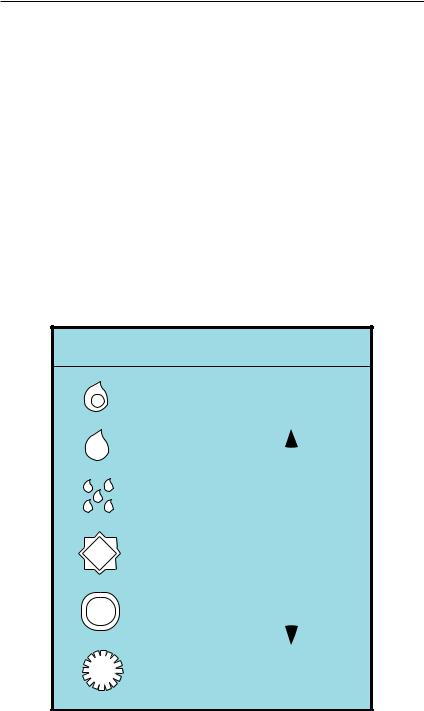
Theory of Operation
RADAR REFLECTIVITY
What target will reflect the radar’s pulses and thus be displayed on the indicator? Only precipitation (or objects more dense than water such as earth or solid structures) will be detected by an X-band weather radar. Therefore weather radar does not detect clouds, thunderstorms or turbulence directly. Instead, it detects precipitation which may be associated with dangerous thunderstorms and turbulence. The best radar reflectors are raindrops and wet snow or hail. The larger the raindrop the better it reflects. Because large drops in a small concentrated area are characteristic of a severe thunderstorm, the radar displays the storm as a strong echo. Drop size is the most important factor in high radar reflectivity. Generally, ice, dry snow, and dry hail have low reflective levels and often will not be displayed by the radar.
A cloud that contains only small raindrops, such as fog or drizzle, will not produce a measurable radar echo. But if the conditions should change and the cloud begins to produce rain, it will be displayed on radar.
Reflective Levels
Wet |
Most |
||
Hail |
Reflective |
||
Rain |
|
|
|
|
|
||
Ice |
|
|
|
Crystals |
|
|
|
Wet |
|
|
|
Snow |
|
|
|
Dry |
|
|
|
Hail |
|
|
|
Least |
|||
Dry |
|||
Snow |
Reflective |
||
Effective Date: 5/98 |
13 |
RDR 2000 Pilot's Guide: Rev 3 |

Theory of Operation
WEATHER DISPLAY CALIBRATION
The radar display has been calibrated to show five levels of target intensity: Black (level 0), Green (level 1), Yellow (level 2), Red (level 3), and Magenta (level 4). The meaning of these levels is shown in the following chart as to their approximate relationship to the Video Integration Processor (VIP) intensity levels used by the National Weather Service. These levels are valid only when; (1) the Wx and WxA mode are selected; (2) the displayed returns are within the STC range of the radar (approximately 40 miles); (3) the returns are beam filling; (4) there are no intervening radar returns.
|
|
|
|
|
Video Integrated Processor (VIP) |
|
|
||||
|
Display |
Rainfall Rate |
|
Categorizations |
|
|
Remarks |
|
|||
|
Level |
|
|
|
|
|
|
|
|
|
|
|
|
|
|
Storm |
VIP |
Rainfall Rate |
|
||||
|
|
|
|
|
|
|
|||||
|
|
mm/Hr. |
|
In./Hr. |
Category |
Level |
mm/Hr. |
|
In./Hr. |
|
|
|
|
|
|
|
|
|
Greater |
|
|
Severe turbulence, |
|
|
|
|
|
|
|
|
|
|
large hail, lightning, |
|
|
|
|
|
|
|
Extreme |
6 |
Than |
|
5 |
|
|
|
|
|
|
|
|
extensive wind gust, |
|
||||
|
|
Greater |
|
Greater |
|
|
125 |
|
|
|
|
|
4 |
|
|
|
|
|
and turbulence. |
|
|||
|
Than |
|
Than |
|
|
|
|
|
|
||
|
(Magenta) |
|
|
|
|
|
|
|
|
||
|
50 |
|
2 |
|
|
|
|
|
Severe turbulence, |
|
|
|
|
|
|
|
|
|
|
|
|||
|
|
|
|
|
Intense |
5 |
50-125 |
|
2-5 |
lightning,organized |
|
|
|
|
|
|
|
wind gusts, hail |
|
||||
|
|
|
|
|
|
|
|
|
|
|
|
|
|
|
|
|
|
|
|
|
|
likely. |
|
|
|
|
|
|
|
|
|
|
|
|
|
|
|
|
|
|
Very |
4 |
25-50 |
|
1-2 |
Severe turbulence |
|
|
|
|
|
|
Strong |
|
likely, lightning. |
|
|||
|
|
|
|
|
|
|
|
|
|
||
|
3 |
12-50 |
|
0.5-2 |
|
|
|
|
|
|
|
|
(Red) |
|
|
|
|
|
|
|
|
||
|
|
|
|
Strong |
3 |
12-25 |
|
0.5-1 |
Severe turbulence, |
|
|
|
|
|
|
|
|
|
|||||
|
|
|
|
|
|
possible lightning. |
|
||||
|
|
|
|
|
|
|
|
|
|
|
|
|
|
|
|
|
|
|
|
|
|
|
|
|
|
|
|
|
|
|
|
|
|
Light to moderate |
|
|
2 |
4-12 |
|
0.17-0.5 |
Moderate |
2 |
2.5-12 |
|
0.1-0.5 |
turbulence is |
|
|
(Yellow) |
|
|
possible with |
|
||||||
|
|
|
|
|
|
|
|
|
|
||
|
|
|
|
|
|
|
|
|
|
lightning. |
|
|
|
|
|
|
|
|
|
|
|
|
|
|
|
|
|
|
|
|
|
|
|
Light to moderate |
|
|
1 |
1-4 |
0.04-0.17 Weak |
1 |
0.25-2.5 |
|
.01-0.1 |
turbulence is |
|
||
|
(Green) |
|
possible with |
|
|||||||
|
|
|
|
|
|
|
|
|
|
||
|
|
|
|
|
|
|
|
|
|
lightning. |
|
|
0 |
Less |
|
Less |
|
|
|
|
|
|
|
|
Than |
|
Than |
|
|
|
|
|
|
|
|
|
(Black) |
|
|
|
|
|
|
|
|
||
|
1 |
|
0.04 |
|
|
|
|
|
|
|
|
|
|
|
|
|
|
|
|
|
|
||
|
|
|
|
|
|
|
|
|
|
||
|
|
Radar Display and Thunderstorm Levels |
|||||||||
|
|
|
|
|
Versus Rainfall Rates |
|
|
|
|||
Effective Date: 5/98 |
|
|
14 |
|
RDR 2000 Pilot's Guide: Rev 3 |
||||||

Theory of Operation
WEATHER ATTENUATION COMPENSATION
An extremely important phenomena for the weather avoidance radar operator to understand is that of attenuation. When a radar pulse is transmitted into the atmosphere, it is progressively absorbed and scattered so that it loses its ability to return to the antenna. This attenuation or weakening of the radar pulse is caused by two primary sources, distance and precipitation. The RDR 2000 has several advanced features which significantly reduce the effects of attenuation (no airborne weather radar can eliminate them completely). It is therefore up to the operator to understand the radar’s limitations in dealing with attenuation.
Attenuation because of distance is due to the fact that the radar energy leaving the antenna is inversely proportional to the square of the distance. For example, the reflected radar energy from a target 60 miles away will be one fourth (if the target is beam filling) of the reflected energy from an equivalent target 30 miles away. The displayed effect to the pilot is that as the storm is approached, it will appear to be gaining in intensity. To compensate for distance attenuation both Sensitivity Timing Control (STC) and Extended STC circuitry are employed. The RDR 2000 has an STC range of 0 to approximately 40 nautical miles. Additionally, the radar will electronically compensate for the effects of distance attenuation with the net effect that targets do not appear to change color as the distance decreases.
Outside the STC range the Extended STC circuitry increases the displayed intensity to more accurately represent storm intensity. The Extended STC will not, however, totally compensate for distance attenuation and, therefore, targets in this range can be expected to show more detail as the distance decreases until reaching the STC range.
Attenuation due to precipitation is far more intense and is less predictable than attenuation due to distance. As the radar pulses pass through moisture, some radar energy is reflected. But much of that energy is absorbed. If the rain is very heavy or extends for many miles, the beam may not reach completely through the area of precipitation. The weather radar has no way of knowing if the beam has been fully attenuated or has reached the far side of the precipitation area. If this beam has been fully attenuated the radar will display a “radar shadow” which appears as an end to the precipitation when, in fact, the heavy rain may extend for many more miles. In the worst case, precipitation attenuation may cause the area of heaviest precipitation to be displayed as the thinnest area of heavy precipitation. It may cause one cell containing heavy precipitation to totally block or shadow a second heavy cell located behind the first cell and prevent it from being displayed on the radar. Never fly into radar shadows and never believe that the full extent of heavy rain is being seen on radar unless another cell or a ground target can be seen beyond the heavy cell. Proper use of the antenna tilt control can help detect radar shadows.
Effective Date: 5/98 |
15 |
RDR 2000 Pilot's Guide: Rev 3 |

Theory of Operation
Attenuation can also be a problem when flying in a large area of general rain. If the rain is moderate, the radar beam may only reach 20 or 30 miles before it is fully attenuated.
The pilot may fly along for many miles seeing the same 20-30 nautical miles of precipitation ahead on the radar when, actually, the rain may extend a great distance. In order to aid in reducing the effects of precipitation attenuation, the RDR 2000 contains sophisticated weather attenuation compensation circuitry. The attenuation compensation feature is totally automatic in the Wx/WxA mode of operation and requires no pilot action to activate other than selecting Wx/WxA mode of operation. The compensation logic operates between 3 to 240 nautical miles, whenever a level 2 (yellow), 3 (red) or 4 (magenta) echo is displayed. The compensation circuits cause the software to measure each individual cell return and increase each individual cell return independently while the antenna scans the sector containing heavy rain. The compensation circuitry allows the radar beam to effectively look deeper into and through heavy rain to search for possible storm cells beyond. While attenuation compensation does not eliminate precipitation attenuation, it does allow the radar to see through more rain at short ranges where every bit of weather information possible is needed. If there is suspicion that the radar is attenuating due to precipitation, exercise extreme caution and ask ATC what they are showing. Often the ground based ATC controller’s radar will have a better overall picture of a large rain area and the pilot can compare the controller’s information with his own radar picture to avoid the strongest cells in a general area of rain.
Effective Date: 5/98 |
16 |
RDR 2000 Pilot's Guide: Rev 3 |
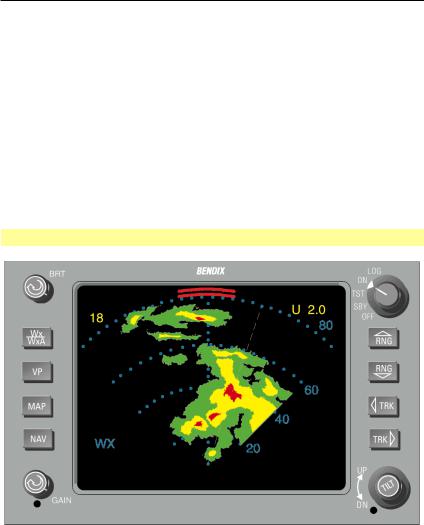
Theory of Operation
TARGET ALERT
The RDR 2000 system can be configured at installation to include the Target Alert feature. The purpose of the feature is to alert the pilot to the presence of a significant weather cell that exists beyond the currently selected range. For this mode to be active, Wx or WxA mode must be selected and Vertical Profile must not be selected. The criteria for a Target Alert is for the cell to be at least red intensity, within ±10˚ of aircraft heading, a minimum size of 2 NM in range and 2 degrees in azimuth, and within the range of 80 to 240 NM. When a Target Alert is issued, two red arcs, separated by a black arc will be displayed at the top of the display centered on the aircraft heading (see the following figure). Target Alert is applied to each scan independent of the other when the radar is alternating scans.
Note: Target Alert is not active in the ground map mode.
Effective Date: 5/98 |
17 |
RDR 2000 Pilot's Guide: Rev 3 |

Theory of Operation
ALTITUDE RING (RANGE RING)
Not all radar transmitted energy is contained in the main beam radiation pattern. Some of the energy is radiated in the side lobe pattern. The characteristics of some radomes and/or nose caps can cause detrimental side lobe radiation. Should this occur, the side lobe can be radiated down toward the earth and the reflected energy received by the radar may be displayed on the indicator as a narrow ring of video. When the indicator is on the 10 or 20 nm range, this can be seen at a distance corresponding to the altitude, typically one mile per 6000 feet. During “Wx” operation, when this phenomenon occurs, no appreciable degradation of the radar to depict weather exists. This phenomenon is largely dependent upon the shape and physical condition of the radome or nose cap on the aircraft.
RADOMES
A radome is a covering that shields the radar antenna from hostile environments, such as fast moving air, rain, bugs, and ice. It allows the microwave energy to pass through relatively undisturbed. This means that very little of the microwave energy passing through it will be absorbed, reflected, or redirected as a result of it’s presence. Some radomes closely approximate this definition, while others do not.
Here are some faults which can occur in radomes:
1.A pitted honeycomb radome can result from being struck by high velocity projectiles, such as rain, ice, sand, bugs, etc. Once the surface integrity has been broken, water intrusion can occur and cause significant radar signal loss.
2.A poorly sealed plastic radome nose boot which has allowed moisture to be trapped behind it.
3.Paint containing metallic particles mistakenly applied to all or part of the radome.
4.An improperly fabricated fiberglass radome.
5.A poorly repaired “ding” on the radome.
6.An object, usually metallic, located inside the radome and in the path of part of the transmitted microwave energy.
As a result of items 5 and 6 above, a “phantom ring” may appear on the radar display. Normally the cause is an obstruction in the bottom of the radome. This obstruction can cause some of the radiated energy to be directed down to the ground instead of in the forward direction. Reflective material in the top of the radome can result in the same situation. In either case, energy returns from the same direction that it was transmitted causing an “altitude ring” to be presented on the radar dis-
Effective Date: 5/98 |
18 |
RDR 2000 Pilot's Guide: Rev 3 |
